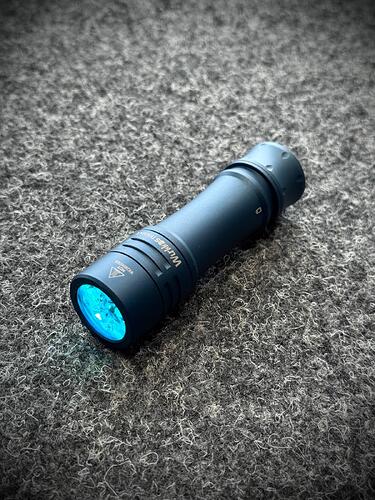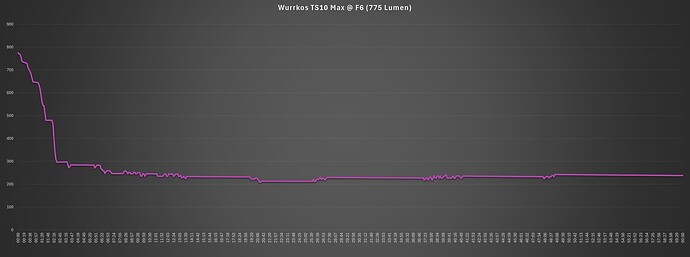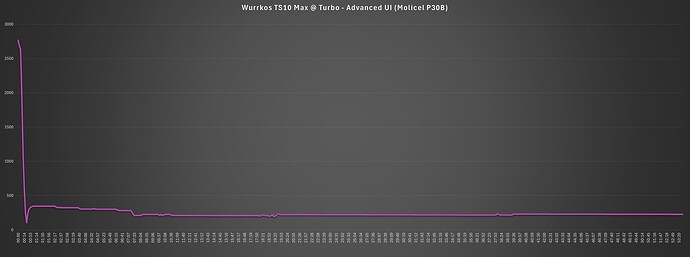Yes, of course my man. All the wurkkos pictures can be freely message and shared. It’s our pleasure
Thanks.
I have exactly the same issue with the included battery. In the Simple UI, the light works without any problems. As soon as I switch to the Advanced UI and ramp to the highest brightness, the TS10 Max turns off and can no longer be switched on. Then the head has to be unscrewed and screwed on again before it will work again.
LG 18650s and the Molicel P30B work without any problems.
I got mine today. I’d say it’s pretty close to what I’d expect from a scaled-up TS10. Interestingly, I haven’t been able to trip the protection with the included battery. It’s fully-charged, I’m trying turbo, in advanced UI, made sure the top of the ramp is at 150… maybe I need to fiddle around with it to make sure turbo isn’t disabled. I haven’t tried any unprotected, high drain batteries yet.
I just finished de-doming. I did it one-by-one and took lux readings as I went (with turbo):
Stock (domed) - 12,370 cd, 222 m
One de-domed - 14,150 cd, 238 m
Two de-domed - 15,380 cd, 248 m
Three de-domed - 15,920 cd, 252 m
So de-doming increased throw by about 14% (if I have my lux meter and the math figured out). The hotspot is a little bit tighter. Overall I think de-doming is worth it for the lower CCT/duv but it did introduce some artifacts in the beam - not too noticeable unless you’re looking for them, though.
I found out that the output of the Simple UI is limited to just under 1400 lumens and an estimated 14-16 watts. With the Advanced UI and the P30B, I get almost double that. This means that the lamp draws more power in the Advanced UI than the supplied USB-C battery can manage. That’s why the light shuts off.
But in general, the device with the Molicel P30B already has plenty of power in the Advanced UI:
- Turbo On: 2,768 lumens
- After 5 seconds: 2,560 lumens
- After 10 seconds: 1,147 lumens
- After 20 seconds: 241 lumens
- After 30 seconds: 102 lumens
- then rises to 345 lumens and stabilizes at 225 lumens after 40 minutes.
- Output: 0.45 - 2,768 lumens
- CCT: 4809k - 5193k
- Duv: 0.0001 - 0.0011
Interesting. Can you imagine this is on purpose? Personally I doubt that since the protection circuit of the provided battery shuts off.
That’s just my guess, because I can’t measure more than 1,400 lumens with the supplied USB-C battery and the P30B in Simple UI. As soon as I switch to the Advanced UI, I get far above the value up to 2,768 lumens, but only with the P30B. With the USB-C battery the TS10 Max simply switches off as soon as approx. 2000 lumens are reached.
Wurkko’s support wrote me this:
Regarding your TS10 max feedback, it is indeed a problem that the anduril program and the battery are not compatible.
We are asking the anduril UI engineers to modify the relevant program of TS10 max and adjust it to a program with slightly lower output so that it can open Turbo mode normally in the future. We will make the new program download link public on our social media and website in the future.
What’s the highest output this light can sustain for more than an hour?
For example if you were to turn the light on somewhere between 300-600 lumens from the very start without using turbo?
Is there any way you can test that preferably while using the highest capacity battery 3500 mah or perhaps you even have the vapcell 3800 mah?
Thanks
Sure. I chose level F6, which according to Wurkkos has 900 lumens. I measured just under 770 lumens and have now started a 60-minute test.
It’s simple: In the default configuration, Simple UI is limited to level 130/150, while Advanced UI can access level 150/150. Because brightness is not perceived linearly, you get a large difference in lumens for the last few levels.
It’s not related to Anduril. The battery can’t handle the current of full turbo mode. So what they suggested was to reduce the maximum brightness of the light to a level that works with their USB-C rechargeable battery.
Pretty obvious, isn’t it. Their better option would be to ditch the USB chargeable/protected cell and include a cell that can support the capabilities of the light… Instead of handicapping the light to suit a crappy cell. Which then penalizes the people that chose to use a capable cell.
I messed around with mine some more and still can’t trip the protection. I’m in advanced UI (I can get to candle mode, for example) and I believe I confirmed the ceiling at level 150.
What version does yours show? I believe mine indicates 1713, 2123, 17, 29. Is it possible mine is a newer version and they hard-coded a turbo limit?
Then again, I just tested with a 30Q of basically the same voltage. I can’t measure lumens but I got 322 lux with the stock battery and 413 lux with the 30Q.
I also have not got mine to trip using the included cell. But I only tested turbo for about 60 seconds a few times. I did not try to repeatedly activate 150/150 after step down. I have just been using the F38 for daily use. With no issues.
Thank you! Lower sustained lumen than a D3AA is pretty eh for a 18650 class light… Wish they gave it a boost driver. At least we should get a buck soon-ish.
So it seems to me that even with a buck driver this light will only be able to sustain around 200 lumens max for about 4 hours with a 3500 mah battery…
If it sustains ~230lm with a FET, it will sustain more with a buck for sure.
Regarding runtime with a Buck, 519A lm/W are known. Bucks should be ~95% efficient. The rest is math. But first we need to know how many lm it can sustain with a buck. My guess is 400, as it does not have deep cooling fins and a tiny head.
Cooling fins don’t buy you much unless the atre huge. Something no pocket lights have. But yes the head…well the whole light is small. No thermal mass to absorb, distribute and dissipate the heat is the real problem. OTH, 400 lumens for a couple of hours wouldn’t be bad at all.
I kinda doubt the buck river will make much difference in brightness increase, but judging by other lights on the market it does usually almost double the runtime.
Plus I think the guy who did the test used a 2600 mah cell, with a 3500 mah cell, I think the light will probably be able to do around 280 lumens for about 3.5-4 hours.
If it doubles the runtime, it also allows for almost twice the sustained brightness (measured, not perceivd). The energy gotta go somewhere. Double the runtime means half the energy losses, and half the energy losses also means you can double the output power at the same energy loss and runtime as the FET.


